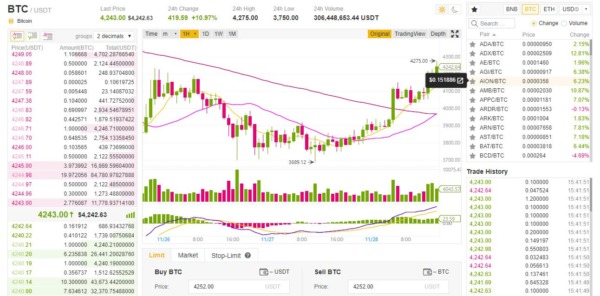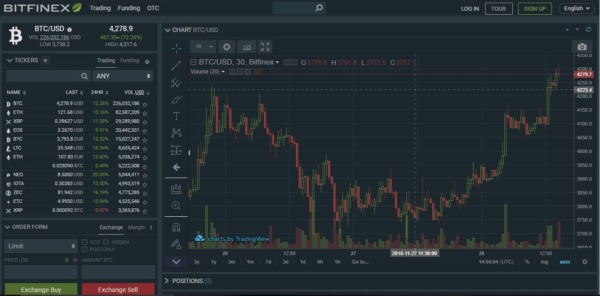In this exchange comparison, we take a closer look at Binance vs Bitfinex, 2 of the top cryptocurrency exchanges.
Both exchanges are constantly ranked among the top 10 crypto exchanges by daily trade volume. Each has their own peculiarities and advantages that make it appealing to users and traders.
Binance was founded in July 2017 on the back of an ICO that offered an ERC-20 utility coin, BNB, to investors. Bitfinex, on the other hand, was founded in October 2012. Both exchanges were founded in Asia, with Binance headquartered in Malta and Bitfinex headquartered in Hong Kong.
Here, we examine the similarities and differences in Binance vs Bitfinex, and assess which is the better choice.
Binance vs Bitfinex
Type of Crypto Exchange
There are 2 types of crypto exchanges: crypto-to-crypto exchanges and fiat-to-crypto exchanges.
Crypto-to-crypto exchanges only accept trades among cryptocurrencies, whereas fiat-to-crypto exchanges allow trades to be made between fiat currencies (such as USD, GBP, and JPY) and cryptocurrencies.
Binance is an example of crypto-to-crypto exchange. They do not accept deposits or trades in any fiat currency. although the company is currently working on some fiat-to-crypto exchange projects.
Bitfinex is a fiat-to-crypto exchange and also a crypto-to-crypto exchange. Bitfinex accepts the following fiat currencies: Euro, Yen, Pound Sterling, and US Dollar. It is also possible to trade in crypto pairs on Bitfinex. Bitfinex allows deposits and withdrawals via wire transfer for fiat currencies.
Cryptocurrencies Supported
Binance currently has 385 cryptocurrencies listed on its platform. Most of the cryptocurrencies have Bitcoin and Ethereum trading pairs. Binance also has trading pairs in USDT and BNB.
Bitfinex currently has 114 cryptocurrencies supported on their platform. These include the popular cryptocurrencies such as Bitcoin, Ethereum, Litecoin, and Monero, as well as small-cap cryptocurrencies such as Metaverse ETP, Nucleus Vision, and Kyber Network.
Countries Supported
Binance accepts users from every part of the world. It does not accept fiat currency, and hence does not need to conform to the financial regulations of any one country.
At this time, Bitfinex does not accept users that are U.S. residents. They discontinued this service indefinitely in 2017, for fear that some tokens listed on the platform are being considered as securities by the SEC. It is unclear whether they will resume accepting U.S. citizens anytime soon.
Aside from this limitation, Bitfinex accepts users from around the world.
Ease of Use
Binance is fairly easy to use, suitable for intermediate level traders. You can use our comprehensive guide to create an account and get started on Binance.
For people who have to buy Bitcoin on a fiat-to-crypto exchange first before transferring to Binance, this guide takes you through the process of transferring Bitcoin from Coinbase (a fiat-to-crypto exchange and wallet). Binance also has a mobile platform.
Bitfinex is slightly different from Binance, as it is suitable for professional traders.
A minimum account equity of $10,000 is required by new accounts to trade or perform any function. Generally, Bitfinex is not advised for beginners and non-professional traders. Bitfinex also has a mobile platform.
Verification
All that is required to set up an account with Binance is an email address. But that just takes care of level 1 verification (which is limited to withdrawals of 2 BTC per 24 hours). Higher levels of verification require proof of identity (such as passports and photographs) for up to 100 BTC withdrawals per 24 hours (and unlimited).
Verification is crucial on the Bitfinex platform, and it currently takes about 6 to 8 weeks to complete. Verification must be completed before new accounts can be allowed to deposit or withdraw fiat currencies.
This verification requires documents such as government-issued IDs, bank statement, or proof of address, and information such as age, address, telephone number, and email address.
User Interface
Binance has a basic trading interface and an advanced trading interface.
The basic trading interface looks like this:

While this interface is not entirely suitable for beginners, non-professional traders can easily figure it out. if you need help, our Binance guide takes you through the process of buying and selling crypto on Binance.
Bitfinex also has a user interface that is better suited for traders with some experience already.
The Bitfinex trading platform of Bitfinex looks like this:

Fees
Binance has a 0.1% trading fee.
This is already very low compared to other crypto exchanges. What’s more, users get a 25% discount when they pay with Binance’s token, BNB. This discount was 50% in Binance’s 1st year, is currently 25% (in the 2nd year), and will be 12.5% and 6.25% in the company’s 3rd and 4th year.
Deposits on Binance are free, but withdrawals vary for each coin and are regularly adjusted.
Bitfinex has a trading fee that varies between 0 to 0.1% (for maker) and 0.055% to 0.2% (for taker).
It is largely free to deposit cryptocurrencies, but a small fee (based on each coin) is often charged on small deposits (that is, deposits of less than $1,000 equivalent). For bank wires, a fee of 0.1% is charged for deposits with a minimum of $60 USD or EUR.
Bitfinex withdrawal fees for each coin vary, and the fee for a bank wire remains 0.1%. Bitfinex discourages holding funds on the platform that are not used for trading, and so they charge a fee on inactive funds left on the platform.
Security
Binance has been a secure exchange thus far, with no known hack or security breach.
There have been phishing attacks on individual Binance users, but a hacking attempt on the Binance exchange itself has never succeeded. Binance boasts of a fund to secure the funds of users in extreme cases, known as Secure Asset Fund for Users (SAFU). Binance also uses the classic 2-factor authentication to protect users’ accounts.
Bitfinex has a record of a hack that happened in 2016, leading to the loss of about 120,000 bitcoins. It took about 8 months to pay all customers the dollar equivalent of what they lost in the hack.
Since then, the exchange has stepped up the platform’s security by making sure 99.5% of users funds stay offline. Bitfinex uses 2-factor authentication and adds universal 2nd factor (U2F) for interested users.
Customer Support
Both Binance and Bitfinex have good customer support, beginning from the FAQs and trading inquiries (accessible from their respective websites) to opening a support ticket and speaking with a customer service representative.
However, both platforms have challenges keeping up with customer support when trade volume is high, and there are large quantities of issues to be resolved. However, most issues eventually do get resolved.
Conclusion
Binance seems to be the obvious choice between these 2 exchanges for US residents.
However, US residents would still need a fiat-to-crypto exchange to change their USD to crypto before sending it to Binance. Exchanges like Coinbase and Gemini could solve this problem.
Bitfinex is a remarkable choice for professional traders who don’t mind going through the verification process, and who desire the convenience of depositing, trading, and withdrawing in fiat currencies.
Bitfinex also offers margin trading (allowing up to 3.3x leverage) and has an OTC Trading Desk.
Both trading platforms uses APIs, and are important infrastructure for the crypto ecosystem.

